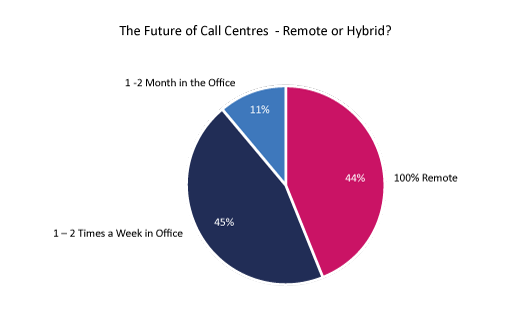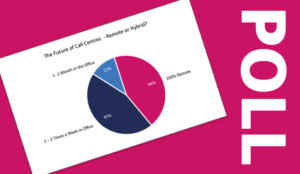With the world gradually returning to normal after the pandemic, there are questions around the future of contact centres.
Diana Marsillo asked our LinkedIn Community “What does the future of your contact centre look like?”
1,003 professionals responded to this poll and the results are as follows:
| Call Centre Type | Response % |
|---|---|
| 100% Remote | 44% |
| 1 – 2 Times a Week in Office | 45% |
| 1 -2 Month in the Office | 11% |
Based on the options available and the responses, it appears that contact centres are adapting to the new normal and turning away from requiring staff to work in the office full-time.
It is important to note that the poll did not allow people to select if their contact centre would be 100% in the office, and without this information, the results do not reflect the opinions of the industry as a whole.
Despite this, the results are useful as they reflect the opinions of the 1,003 professionals who did respond to the poll and this can be used to identify future trends.

With this in mind, 44% of respondents stated the future of the contact centre was 100% remote, suggesting that homeworking trends are working for many.
Fully remote working is not something the majority of contact centres want to do as 56% of respondents stated they would move to hybrid working with employees coming into the office on a regular basis. Of these:
- 45% said their call centre would have employees in the office 1–2 times a week
- 11% said their contact centre would have employees in the office 1–2 times a month
From these results, it is clear that in the future some contact centres will be allowing hybrid or complete remote working.
In addition to the poll results, a number of professionals also shared their opinions on the future of contact centres:
Hybrid Offers the Best Approach
None of the above. I have one call centre going remote, with hoteling stations set up in case of technical issues and for coaching, 1:1 sessions, training and social events. My other centre is 100% in the office.
Two very different industries and levels of business maturity. I see pros and cons in both centres right now, and would say in my opinion hybrid offers the best approach to meet all needs.
Thanks to Katherine
Our Call Centre Has Improved Our Numbers Being Remote
My call centre used to be in the office until Covid hit. Our call centre has improved our numbers since being remote. I have fewer agents calling out for bogus reasons, and since remote, I have had fewer agents leave to find work elsewhere.
This has been an excellent environment for single mothers and those that might have transportation issues.
The remote culture is what you make it as a manager and how you communicate with your staff. It takes a lot more effort as a manager to maintain the company culture you want but it’s well worth the effort.
I leave the decision up to the fully functioning adult whether they want to work in one of our offices or not. Not everyone works and learns the same, so the option is theirs.
I don’t mind my staff being comfortable; why would I want them to be uncomfortable when dealing with angry customers!
Make sure you have the right software to accommodate the remote set-up.
Thanks to Shannon
Never 100% Remote
It should never be 100% remote, as this really impacts your company’s culture and work environment.
Also, as mentioned in some of the comments, some businesses require certain security measures that cannot be met in a WFH module.
WFH has its pros and cons, and without careful planning, it could potentially harm your business’s productivity.
Thanks to Mohaned
100% on Site
100% on site. If you think you’re more productive at home, you’re not, but I am certain you’re more comfortable.
Thanks to John R.
Tom’s opinion is 0% remote. This led to an interesting discussion, where some insightful points were made that contact centres should consider when deciding if they should offer remote working:
I Wouldn’t Say 0%
I wouldn’t say 0% but at the same time, the options provided are one-sided, favouring work from home.
Work from home may be campaign-specific and/or based on performance, depending on data security requirements. Alternative channels to voice may be favoured.
I think there is a stronger connection with people in the office. A valuable social interaction that’s lacking in work from home.
Everyone wants to work from home. It saves them money on transport, saves time, it’s convenient etc..
I get all that, but are the people giving 100% of their time when they are out of sight? Is your client getting the value they are paying for?
This topic can be debated for hours. The employer is not really saving money as tech is required that now adds costs. Connectivity at home may be challenging, creating poor customer experiences. All of a sudden you also need a UPS for power cuts and load shedding etc.
Although we equip our Customer Experience Representatives with UPSs and data where needed, I have called well-known brands and I have thought to myself, how could you promote this poor level of service where I can’t hear the person, knowing they are struggling with data connectivity when they’ve confirmed they’re working from home…
Thanks to Bronwen
The Biggest Cost
We’ve run WFH trials, and the complexity and cost are a thing … however, the biggest cost, in my view, is that you lose your company culture, staff retention and productivity (in most jobs), which is major in my opinion.
Thanks to Tom
People Want Flexible Working
It’s hard to agree with you, Tom, on this one. I’m hearing of people all the time rejecting offers with significantly more pay because it doesn’t offer them flexible working like WFH. So in many cases, failure to offer this is resulting in even higher attrition and disengagement.
As to the culture and productivity, there are methods/platforms that can help with this…
Thanks to Nick
Source: Poll conducted in our LinkedIn Community Sample size – 1,003 Date: 2022
Author: Robyn Coppell
Published On: 16th Sep 2022 - Last modified: 23rd Sep 2022
Read more about - Contact Centre Research, Future, Polls


















